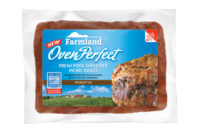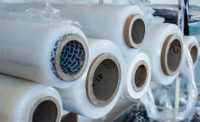Altogether better: Flexible laminations in food packaging

Many of the high-performance, multilayer packaging structures found in flexible food and beverage packaging rely on adhesives to keep them together. The adhesive bond is a way to combine otherwise incompatible materials like film, foil, and/or paper into an integrated, multilayer structure that is greater than the sum of its parts.

|
The Flexible Packaging Association (FPA) pegs the “value-added” segment of the industry, including extrusion, laminating and printing, at $20.3 billion in sales for 2009.
One of the major trends in laminated flexible packaging is increased use of solventless adhesives. Brian Glasbrenner, sales manager, flexible packaging North America for adhesives provider H.B. Fuller, says that water- and solvent-based adhesives make up the bulk of the business in these markets, but that solventless is “gaining traction, making up a lot of ground.”
He explains that for demanding applications, solvent based adhesives are the primary adhesive. Water-based formulations are used for low to medium performance. “Solventless is used for low, medium and now we are seeing performance push to the higher demanding applications,” Glasbrenner says. The advantage of solventless adhesives is a rapid-cure process that cuts production time. This helps meet market pressures for shorter runs and shrinking lead times.
As importantly, Glasbrenner adds, the rapid-cure process also delivers high-performance materials. “We see that a lot of food and beverage applications are moving to solventless,” he emphasizes, noting that some solventless films can withstand hot filling or product steaming inside the bag. Another major player in this market is Henkel Corp., the largest adhesive manufacturer in the world, with sales near $8 billion. Guenther Hering, vice president, flexible packaging North America, agrees about the potential for solventless adhesives: “The growing popularity of solventless adhesives is due to the faster line speeds, the fact that there are large savings in energy cost not having to dry water or solvents, and finally from the reduction in emissions.” As a result, “most of the new laminating equipment is solventless,” he adds.
According to Gering, the most popular packaging films that are laminated using Henkel’s adhesives remain polyethylene and polypropylene. “PP is fairly inexpensive and appropriate for applications including snacks and confections,” he says.
Another workhorse is polyester film, which Gering characterizes as particularly appropriate for higher-heat requirements such as hot fill and retort applications.
Even though flexible packaging remains a highly efficient packaging format, sustainability improvements continue. These include the use of recyclable materials to replace traditional PE films—for example, films made of renewable resources such as polylactic acid (PLA) or cellophane. These materials bring sustainable improvements but also have performance limitations, Gering points out. In response, companies may lower their existing specifications, he suggests, or film providers may be able to increase the performance of these films without sacrificing the sustainable aspect.
There has also been some demand to eliminate a laminated layer in the name of efficiency and sustainability. “Doing that without sacrificing the performance of the package is a challenge,” he notes.
Hering points to a common key markets for both foods and beverages in laminated flexible packaging: Stand-up pouches. On the beverage side, it’s for stand-up drink pouches for juice drinks and other noncarbonated products. “Companies are working to move carbonated beverages into pouches, but that is a [technical] problem,” he adds. On the food side, it’s for packages with improved convenience and particularly with reclosable features.
“It started with [press-to-seal] zippers, but now there are other closures on the market that have the same effect,” Hering says. “Convenience is becoming more important, along with printability that makes the package stand out on the shelf.”
He foresees continued opportunities for flexible packaging to replace traditional containers. As examples he cites the elimination of cereal boxes and replacing aluminum cans with retortable pouches. “All of these are driven by costs, the energy footprint, and other environmental advantages and with more convenience for consumers such as for closure mechanisms,” Hering concludes. F&BP
For more information
Flexible Packaging Assn.
410-694-0800; www.flexpack.org
H.B. Fuller Co.
651-236-5900; www.hbfuller.com
Henkel Corp.
919-319-1933; www.henkelna.com
Looking for a reprint of this article?
From high-res PDFs to custom plaques, order your copy today!








